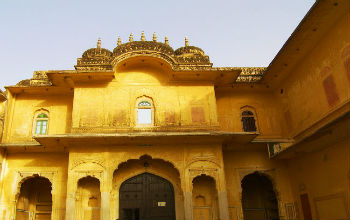Added bonus is the warm hospitality of its people and, of course, a plethora of handicrafts to shop for. In fact, Jaipur is a paradise for all the ethnic lovers. The ethnic dresses one will find here are hard to get from anywhere else. Also, all the dresses are reasonably priced. Tourists can enjoy watching and participating in various festivals that Jaipur hosts - from the modern Jaipur Literary festival to the traditional Teej, Gangaur and Kite festivals.
Summers are very hot in Jaipur, with maximum temperature reaching up to 45°C, while the winters are cool and ideal to plan for a holiday, with temperature dipping down to an average 8.3°.
Jaipur is well-connected by Air with Delhi, Kolkata, Mumbai, Ahmedabad, Jodhpur and Udaipur. Trains are available from the states of Delhi, Agra, Mumbai, Chennai, Bikaner, Jodhpur, Udaipur, Ahmedabad, Uttar Pradesh and Madhya Pradesh.
Tourist Places in Jaipur
Amer Fort
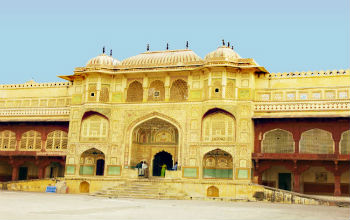 Category : History & Culture
Category : History & CulturePopularly known as Amber Fort, this beautiful fort built by Maharaja Man Singh depicts the artistic Hindu architecture through its cobbled pathways and large entrances. This four-level fort, built with red marbles and sandstone, consists of the royal legacy of Diwan-e-Aam, Diwan-e-Khas, Sheesh Mahal, Sukh Niwas (water cascades making wind blow to create an artificial cool weather) and a temple of Sila Devi. For generations, the royal families used to stay here, and it was secretly connected to the Jaigarh fort for emergency escapes during attacks. More... |
Jaigarh Fort
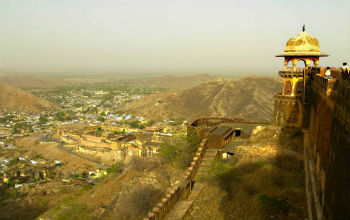 Category : History & Culture
Category : History & CultureThis beautiful creation by Maharaja Jai Singh, located at Amber, Jaipur stands on the Cheel Ka Teela (Hill of Eagles), a promontory of the Aravalli Hills. Located 400 metres above and similar in structure with the famous Amber Fort, it was meant to protect the latter. One can reach the Amber Fort through the secret subterranean passage from Jaigarh Fort. This fort is 3 km long and 1 km wide. It has the world's largest cannon on wheels, called Jaivana; a few palace complexes which served as the residences of the royal families; a well maintained garden; and a museum.More... |
City Palace
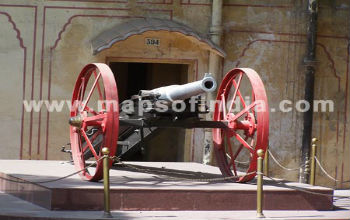 Category : History & Culture
Category : History & CultureThis gigantic fort includes two more forts inside, and is located on the north-east region of Jaipur. City Palace was the seat of the kings. It has a huge array of buildings, courtyards, temples and gardens. Its construction was started by Jai Singh following a perfect blend of Indian and European styles of architecture. The magnificent grid pattern encloses Mubarak Mahal, Chandra Mahal, Mukut Mahal, Palace of Maharani, Govind Temple and City Palace Museum. Chandra Mahal, one of the inner forts of City Palace, has a museum of its own and is still a residence of the royal family members. More... |
Hawa Mahal
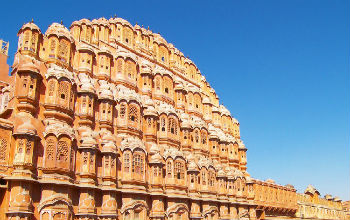 Category : History & Culture
Category : History & CultureHawa Mahal, or the Palace of Winds, built by Maharaja Pratap Singh, is located on the southern part of Jaipur. This beautiful five-storeyed building, designed to replicate the crown of Lord Krishna, looks like a honeycomb having about 1,000 small windows. These have latticework that encouraged cool air or doctor breeze to enter the palace, air-conditioning the whole area during the summers. The pink and red sandstone on the exterior gives it a magnificent look in the morning. The palace is part of the royal City Palace extending till the Zenana or the chambers of women. More... |
Nahargarh Fort
Jantar Mantar
Category : History & Culture
Built by Maharaja Jai Singh, this observatory, officially declared as the national monument, has a huge collection of astronomical instruments. Beautifully crafted in marble and local stone, it is one of the largest buildings in the country that is dedicated to the exploration of celestial bodies. It consists of around 14 fixed and focused devices that measure time, predict eclipses, track stars, and locate earth orbits around the sun.
Jagat Shiromani Temple
Category : Religious
This beautiful temple was erected by the mother of King Jagat Singh, Shringar Devi Kankawat and the construction took nine years to complete, from 1599 to 1608. The west-facing temple is dedicated to the Hindu gods Radha and Krishna, and the building consists of a gaduda chatri, marble torana, a vestibule, a square sactrum crowned with sikhara, a mandapa that lies on a decorated pitha followed by the jangha and vedibandha. The holy mandap has several pillars decorated with lateral transepts and a vaulted ceiling with religious paintings.
Jal Mahal
Category : History & Culture
Literally translated to "Water Palace", this beautiful architecture is situated in the middle of a lake called the Sagar Lake, in the city of Jaipur. Both of these were renovated as well as enlarged by King Jai Singh in the 18th century. The halls inside the palace at the first floor are well-decorated, but cannot surpass the aromatic beauty of the Chameli Bagh upstairs. The area is surrounded by the Aravallis, other forts, temples, and mesmerizing natural beauty. The lake has a well-established drainage system, the required depth for fishes to be alive, and five man-made islands for attracting migratory birds. More...
Albert Hall
Category : History & Culture
It is one of the oldest museums in Jaipur as well as in India, and was built by Sir Samuel Jacob in the 19th Century. It is known as the state's museum for Rajasthan and is also known as the Government Central Museum. The beautiful building is located in the Ram Niwas garden, and stands as the epitome of the conglomeration of the Indo-Saracen architecture. Here. one can find a rich collection of numerous artifacts like carpets, paintings, stones, ivory, sculptures made up of metal, crystal works decorated with colours and every item that depicts the royal culture of Rajasthan.
Govind Devji Temple
Category : Religious
Govind Devji Temple lies inside the City Palace. The Krishna deity, said to be the facial image of Lord Krishna, is originally from Vrindavan and was re-installed here by Jai Singh II. The Lakshmi Narayan Temple lies close to Moti Doongri Palace.
Sisodia Rani Palace
Category : History & Culture
Other interesting spots some distance away are Sisodia Rani Palace, newly renovated with beautiful gardens, and Gaitor, a memorial to former Maharajas. At Galtaji, there is a sun temple.
ass="content_headingtop" id="nearjaipur">Tourist Destinations Near Jaipur
Excursions from Jaipur can be made to interesting places.
- Bagru, 35 km south of Jaipur is famous for its hand printed cloth industry while Sanganer, at a distance of 16 km from Jaipur is famous for its traditional crafts. There is also a Digamber temple dedicated to Lord Parswanth here.
- Pushkar is an important pilgrimage destination for the Hindus and also famous for the cattle fair called the Pushkar fair.
- Ramgarh Lake, 32 km north east of Jaipur is a good picnic spot with its huge artificial lake. More...
- Samod, 40 km north-west of Jaipur has an old place, which is a perfect example of the Rajput Haveli architecture.
- The wild life enthusiasts can head for Ranthambore and Sariska, which are famous wild life sanctuaries.
Places to Visit in Jaipur

